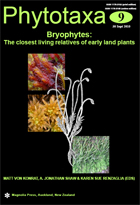Abstract
Fungal symbioses are one of the key attributes of land plants. The twenty first century has witnessed the increasing use of molecular data complemented by cytological studies in understanding the nature of bryophyte-fungal associations and unravelling the early evolution of fungal symbioses at the foot of the land plant tree. Isolation and resynthesis experiments have shed considerable light on host ranges and very recently have produced an incisive insight into functional relationships. Fungi with distinctive cytology embracing short-lived intracellular fungal lumps, intercellular hyphae and thick-walled spores in Treubia and Haplomitrium are currently being identified as belonging to a more ancient group of fungi than the glomeromycetes, previously assumed to be the most primitive fungi forming symbioses with land plants. Glomeromycetes, like those in lower tracheophytes, are widespread in complex and simple thalloid liverworts. Limited molecular identification of these as belonging to the derived clade Glomus Group A has led to the suggestion of host swapping from tracheophytes. Ascomycetes, all identified to date as Rhizoscyphus ericae and having an extremely wide host range extending into the Ericales, occur in the rhizoids of a range of leafy liverwort families that are sister to the Schistochilaceae, where the fungus induces rhizoid branching and septation. Dating of the Schistochilaceae suggests that these liverwort rhizoid associations predated ericoid mycorrhizas. A more restricted distribution of basidiomycetes, all identified as members of the genus Sebacina, is interpreted as a secondary acquisition in leafy liverworts following the loss of ascomycetes. Unlike the latter and ectomycorrhizal basidiomycetes in tracheophytes, these are host specific. Whereas there is no evidence of host digestion for either the ascomycetes or basidiomycetes in leafy liverworts, basidiomycetes in the Aneuraceae display regular colonization and digestion cycles. Considerable molecular diversity in the aneuracean fungi, mainly in the genus Tulasnella with occasional sebacinoids, mirrors the same in the host liverworts. Nesting of the only mycoheterotrophic liverwort Cryptothallus within Aneura is congruent with the phylogeny of the endophytes. Glomeromycete fungi have been identified in Phaeoceros and Anthoceros whereas Dendroceros, Megaceros and Nothoceros lack endophytes but the distribution of fungi across hornworts has yet to be explored. In contrast to liverworts and hornworts, there is no evidence of mycorrhiza-like associations in mosses. Claims that the fossil Prototaxites was a fossil fungus-associated liverwort are discounted.

